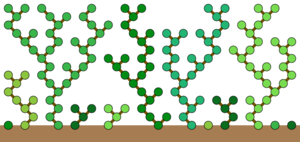Cellular automaton (nonfiction): Difference between revisions
(Created page with "300px|thumb|Rule 90: a forest of stunted trees.A '''cellular automaton''' (pl. '''cellular automata''', abbrev. '''CA''') is a discrete model studie...") |
No edit summary |
||
| (12 intermediate revisions by the same user not shown) | |||
| Line 5: | Line 5: | ||
A cellular automaton consists of a regular grid of cells, each in one of a finite number of states, such as on and off. | A cellular automaton consists of a regular grid of cells, each in one of a finite number of states, such as on and off. | ||
The concept was originally discovered in the 1940s by Stanislaw Ulam and John von Neumann while they were contemporaries at Los Alamos National Laboratory. | The concept was originally discovered in the 1940s by [[Stanislaw Ulam (nonfiction)|Stanislaw Ulam]] and [[John von Neumann (nonfiction)|John von Neumann]] while they were contemporaries at Los Alamos National Laboratory. | ||
While studied by some throughout the 1950s and 1960s, it was not until the 1970s and Conway's Game of Life, a two-dimensional cellular automaton, that interest in the subject expanded beyond academia. | While studied by some throughout the 1950s and 1960s, it was not until the 1970s and Conway's Game of Life, a two-dimensional cellular automaton, that interest in the subject expanded beyond academia. | ||
| Line 13: | Line 13: | ||
== In the News == | == In the News == | ||
<gallery | <gallery> | ||
Bernoulli_wappen.png|link=Bernoulli family (nonfiction)| | Bernoulli_wappen.png|link=Bernoulli family (nonfiction)|Latest version of [[Bernoulli family (nonfiction)|Bernoulli family tree]] powered by cellular automata. | ||
</gallery> | </gallery> | ||
== Fiction cross-reference == | == Fiction cross-reference == | ||
* [[Battle Cry of the Cellular Automata]] | |||
* [[John von Neumann (nonfiction)]] | |||
* [[Mathematics]] | * [[Mathematics]] | ||
== Nonfiction cross-reference == | == Nonfiction cross-reference == | ||
* [[ | * [[Firing squad synchronization problem (nonfiction)]] - a cellular automaton that, starting with a single active cell, eventually reaches a state in which all cells are simultaneously active | ||
* [[Garden of Eden (mathematics) (nonfiction)]] - a cellular automaton configuration that has no predecessor | |||
* [[Golly (program) (nonfiction)]] | |||
* [[Stanislaw Ulam (nonfiction)]] | |||
* [[Turing completeness (nonfiction)]] | * [[Turing completeness (nonfiction)]] | ||
* [[Von Neumann neighborhood (nonfiction)]] | |||
External links: | |||
* [https://en.wikipedia.org/wiki/Cellular_automaton Cellular automaton] @ Wikipedia | * [https://en.wikipedia.org/wiki/Cellular_automaton Cellular automaton] @ Wikipedia | ||
[[Category:Nonfiction (nonfiction)]] | [[Category:Nonfiction (nonfiction)]] | ||
[[Category: | [[Category:Cellular automata (nonfiction)]] | ||
[[Category:Mathematics (nonfiction)]] | [[Category:Mathematics (nonfiction)]] | ||
Latest revision as of 07:56, 5 March 2018
A cellular automaton (pl. cellular automata, abbrev. CA) is a discrete model studied in computability theory, mathematics, physics, complexity science, theoretical biology and microstructure modeling.
Cellular automata are also called cellular spaces, tessellation automata, homogeneous structures, cellular structures, tessellation structures, and iterative arrays.
A cellular automaton consists of a regular grid of cells, each in one of a finite number of states, such as on and off.
The concept was originally discovered in the 1940s by Stanislaw Ulam and John von Neumann while they were contemporaries at Los Alamos National Laboratory.
While studied by some throughout the 1950s and 1960s, it was not until the 1970s and Conway's Game of Life, a two-dimensional cellular automaton, that interest in the subject expanded beyond academia.
In the 1980s, Stephen Wolfram engaged in a systematic study of one-dimensional cellular automata, or what he calls elementary cellular automata; his research assistant Matthew Cook showed that one of these rules is Turing-complete.
In the News
Latest version of Bernoulli family tree powered by cellular automata.
Fiction cross-reference
Nonfiction cross-reference
- Firing squad synchronization problem (nonfiction) - a cellular automaton that, starting with a single active cell, eventually reaches a state in which all cells are simultaneously active
- Garden of Eden (mathematics) (nonfiction) - a cellular automaton configuration that has no predecessor
- Golly (program) (nonfiction)
- Stanislaw Ulam (nonfiction)
- Turing completeness (nonfiction)
- Von Neumann neighborhood (nonfiction)
External links:
- Cellular automaton @ Wikipedia

